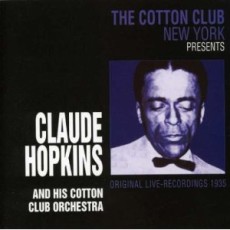
Daily Dose Of Jazz…
Claude Driskett Hopkins was born on August 24, 1903 in Alexandria, Virginia to Howard University faculty parents. A highly talented stride piano player and arranger, he left home at 21 as a sideman with the Wilbur Sweatman Orchestra but stayed less than a year. In 1925, he left for Europe as the musical director of The Revue Negre that starred Josephine Baker with Sidney Bechet in the band.
Returning to the USA in 1927, Hopkins based himself in Washington, toured the TOBA circuit with The Ginger Snaps Revue before heading once again to NYC where he took over the band of Charlie Skeets. Between 1932-36 he led a fairly successful Harlem band employing many jazz musicians who were later to become famous in their own right such as Edmond Hall, Jabbo Smith and Vic Dickerson. This was his most successful period with long residencies at the Savoy and Rosewood ballrooms, and at the Cotton Club. In 1937 he took his band on the road with a great deal of success but by 1940 dissolved the band.
Using his arranging talents, Claude began working for several non-jazz bandleaders and for CBS. In 1948/9 he led a “novelty” band briefly but took a jazz band into The Cafe Society in 1950. From 1951 up until his death, he remained in NYC working mostly as a sideman with Dixieland bands playing at festivals and various New York clubs and recording. Often under-rated in later years, he was one of jazz’s most important bandleaders and has yet to be given full recognition for his achievements. Claude Hopkins passed away on February 19, 1984 a disillusioned and dispirited man.
More Posts: piano
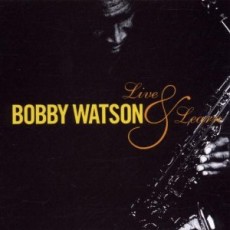
Daily Dose Of Jazz…
Bobby Watson was born in Lawrence, Kansas on August 23, 1953 but grew up in Kansas City, Kansas. He attended the University of Miami along with fellow students Pat Metheny, Jaco Pastorius and Bruce Hornsby. After graduating in 1975, he moved to New York City and joined Art Blakey’s Jazz Messengers. He performed with the Jazz Messengers from 1977 to 1981, eventually becoming the musical director for the group. He also founded the 29th Street saxophone Quartet with alto saxophonist Ed Jackson, tenor saxophonist Rich Rothenberg, and baritone saxophonist Jim Hartog.
Following his tenure as a Jazz Messenger, Watson became a much-sought after musician, working along the way with many notable musicians, including: drummers Max Roach and Louis Hayes, fellow saxophonists George Coleman and Branford Marsalis, multi-instrumentalist Sam Rivers and his trumpeter brother Wynton. In addition Bobby supported vocalists including Joe Williams, Dianne Reeves, Lou Rawls, Betty Carter and Carmen Lundy as well as being a sideman for Carlos Santana, Rufus & Chaka Khan, Bob Belden and John Hicks.
Watson along with Curtis Lundy and Victor Lewis started “Horizon” an acoustic quintet; led the a tribute band to Johnny Hodges called the “High Court of Swing”; and the “Tailor-Made Big Band”. He composed a song for the soundtrack of Deniro’s “A Bronx Tale”; has been an adjunct professor at William Patterson University and the Manhattan School of Music; and is currently involved with the Thelonious Monk Institute’s “Jazz in America” high school outreach program.
Watson was selected as the first William D. and Mary Grant/Missouri, Distinguished Professorship in Jazz Studies. The past six years he has served as the director of jazz studies at the University of Missouri-Kansas City Conservatory of Music and the alto saxophonist, composer, producer and educator still manages to balance recording of 26 albums as a leader, hundreds of co=led or sideman recordings, along with live engagements around the world with his teaching responsibilities. Watson’s ensembles at UMKC have garnered several awards and national recognition.
Bobby Watson, post-bop jazz alto saxophonist, composer, producer, and educator, now has 26 recordings as a leader. He appears on nearly 100 other recordings as either co-leader or in a supporting role and has recorded more than 100 original compositions and his long-time publisher.
More Posts: saxophone
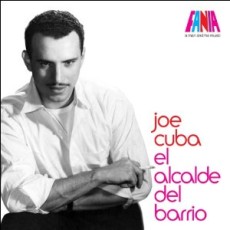
Daily Dose Of Jazz…
Joe Cuba was born Gilberto Miguel Calderon to Puerto Rican parents on April 22, 1931 in Spanish Harlem in New York City. Playing in his father’s organized stickball club “the Devils”, Cuba broke his leg and his attention shifted to the conga. Practicing every free moment between school, after graduating from high school he joined a band.
In 1950, when he was 19 years old, he played for J. Panama and also for a group called La Alfarona X. The group soon disbanding, Cuba enrolled in college to study law. While at college he attended a concert in which Tito Puente performed. He went up to Tito and introduced himself as a student and fan and soon they developed what was to become a lifetime friendship. This event motivated Cuba to organize his own band and in 1954, his agent recommended that he change the band’s name from the Jose Calderon Sextet to the Joe Cuba Sextet, making their debut at the Stardust Ballroom.
In 1962, Cuba recorded “To Be With You” with the vocals of Cheo Feliciano and Jimmy Sabater, Sr. The band became popular in the New York Latin community. The lyrics to Cuba’s music used a mixture of Spanish and English, becoming an important part of the Nuyorican Movement.
In 1965, the Sextet got their first crossover hit with the Latin and soul fusion of “El Pito” (I Never Go Back To Georgia) a chant taken from Dizzy Gillespie’s intro to the seminal Afro-Cuban tune, “Manteca”. Sabater later revealed, “None of them had ever been to Georgia.
Along with fellow Nuyorican artists such as Ray Barretto and Richie Ray, Cuba was at the forefront of the developing Latin soul sound in New York, merging American R&B styles with Afro-Cuban instrumentation. Cuba was one of the key architects behind the emerging Latin Boogaloo sound, which became a popular and influential Latin style in the latter half of the 1960s.
By 1966, his band which included timbales, congas, bongos, bass, vibraphones and piano among its musical instruments scored a U.S. “hit” on the National Hit Parade List with the song “Bang Bang”, kicking off the popularity of the boogaloo. He also had a Billboard #1 hit that same year with “Sock It To Me Baby” .
Inducted into the International Latin Music Hall of Fame in 1999, Joe was named Grand Marshall of the Puerto Rican Day Parade celebrated in Yonkers, New York in 2004; and was also the director of the Museum of La Salsa, located in Spanish Harlem, Manhattan, New York.
Joe Cuba, conga player and Father of Latin Boogaloo was hospitalized for a persistent bacterial infection and passed away on February 15, 2009 in New York City, after being removed from life support.
More Posts: conga
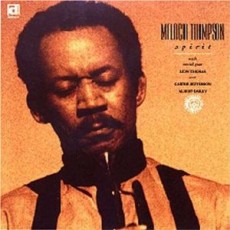
Daily Dose of Jazz…
Malachi Richard Thompson was born on August 21, 1949 in Princeton, Kentucky and moved to Chicago as a child. He credited his interest in the trumpet to hearing Count Basie’s band at the Regal Theatre when he was 11 years old. Malachi worked in the rhythm and blues scene on Chicago’s South Side as a teen and in 1968 he joined the Association for the Advancement of Creative Musicians (AACM), spending some time in the AACM big band. Thompson graduated from Governor’s State University in 1974 with a degree in music composition.
He performed and toured with the Operation Breadbasket Big Band, which was affiliated with the Southern Christian Leadership Conference. He has worked with saxophonists Joe Henderson, Jackie McLean, Frank Foster and Archie Shepp among other musicians while living in New York City. He formed his “Freebop” band in 1978, eventually relocating to Washington, D.C., working with Lester Bowie’s Hot Trumpets Repertory Company and formed Africa Brass, inspired by traditional New Orleans brass bands.
With a goal of preserving the Sutherland Theater on Chicago’s South Side, Thompson founded the Sutherland Community Arts Initiative in 1991, a non-profit corporation, and wrote incidental music for a play about the theater. Diagnosed in 1989 with T-cell lymphoma and learning he had one year to live, Thompson claimed he was healed by radiation and reading about jazz. He died in Chicago from a relapse of his cancer on July 16, 2006.
More Posts: trumpet
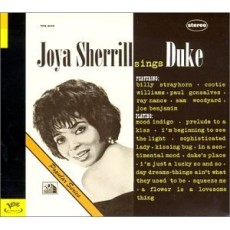
Daily Dose Of Jazz…
Joya Sherrill was born on August 20, 1924 in Bayonne, New Jersey and originally aspired to be a writer. While still in high school her father arranged for an introduction with Duke Ellington in 1942, aged 17. Six months later she joined the orchestra fronting the band as his vocalist. Leaving briefly to attend Wilberforce University, she returned to the group from 1944 to 1946. She had a hit with Ellington’s tune “I’m Beginning to See the Light”.
Subsequently, she worked as a soloist, performing with Rex Stewart, Ray Nance and others into the 1960s. She returned to Ellington for 1959’s A Drum Is A Woman. She toured the U.S. in 1959 and then took a role in the Broadway show “The Long Dream”. She toured with Benny Goodman in the USSR in 1962 and then returned to sing with Ellington in 1963.
One of the first Blacks to host a television program, from 1970 to 1982 she had a children’s television show, “Time for Joya”, later called “Joya’s Fun School. Although she only taped a few years worth of original episodes, the show would be seen in reruns for twelve years. Late in the 1980s she hosted a children’s show in the Middle East.
Joya Sherrill, jazz vocalist, died of complications from leukemia on June 28, 2010 in Great Neck, New York at the age of 85.
More Posts: vocal

